For the rebuilding Detroit Tigers, hitting on their draft picks was always going to be crucial, especially so for their first-round picks. As a former first overall pick and top prospect, the expectations were always going to be set extremely high for Casey Mize. However, after fast-tracking through the minors and making his Major League debut last season, it feels as if the overall impressions have been a little underwhelming to this point. It seems like Mize has still yet to get going in full swing since his debut last year and has been a little inconsistent. That’s okay, though; it shouldn’t exactly be expected for a pitcher to come right up and set the world on fire and start dominating right from the beginning–pitching is hard after all. Things are definitely better this season though, after a lackluster 6.99 ERA in 28 innings last year, Mize is performing much better this year. He has gotten his ERA down to 3.69 and looks to be heading in the right direction recently, with a 1.83 ERA in his last three starts.
There are actually a lot of reasons to be excited about Mize right now, both in terms of results and the fact that he looks a bit different as a pitcher. Some of his improvement looks to be due to some tweaks and adjustments he’s already made. It’s good to see him already start to adapt and change things up as he gets more experience in the Majors. Some of those changes look to be good ones for him so far, and I think Mize can continue to make some more tweaks which can maybe help him get to an even higher level. Let’s take a closer look.
One of the bigger changes Mize has already made this season has to do with his release point. It’s a bit of a subtle change, but it looks like Mize has raised his release point this season as compared to last year:
It’s probably easier to show this visually. First, here’s his average release point visualization from last year:
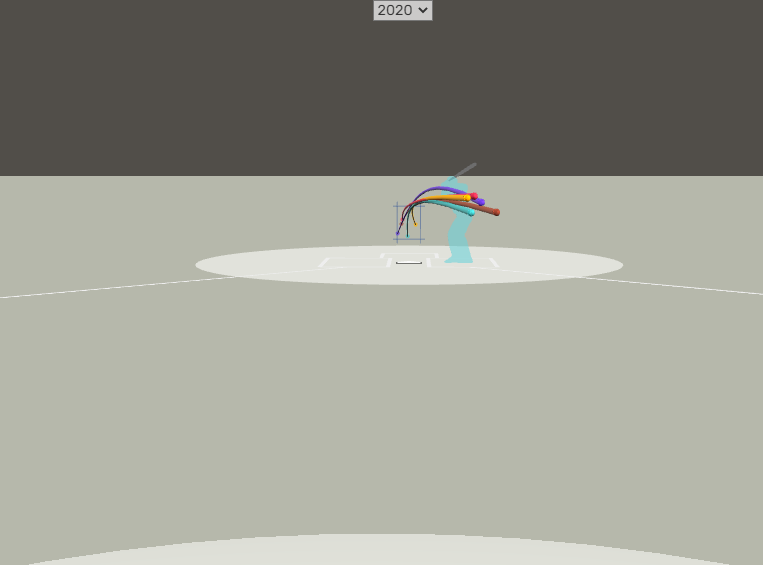
And then next, a look at the same thing visualization from this year:
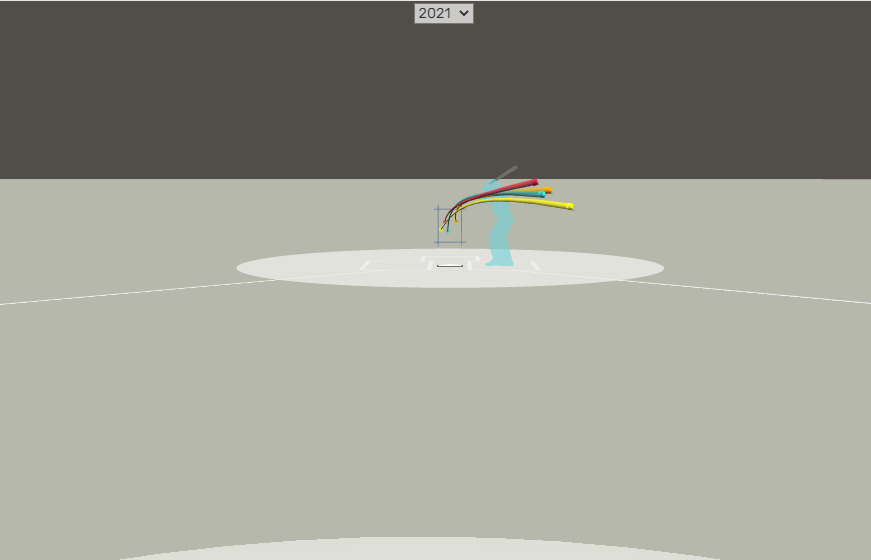
Mize already does a good thing in that he keeps his average release points for all of his pitches clustered together, especially when viewed in plot form. But, raising his release point and the overall difference that makes is changing how his pitches move and the overall pitch quality. This change looks to have mainly impacted his slider (Note: Mize’s cutter in 2020 has been reclassified as a slider this year). Fellow Pitcher List writer Natan Cristol-Deman described the differences in Mize’s slider in this post, and it’s still true—Mize’s slider is moving much better this year than last year:
The difference in release point also appears to be helping out his other pitches too—the four-seamer and curveball specifically. It’s pretty straightforward for these two pitches, as Mize is getting more rise on his four-seamer this year and more drop on the curveball, both of which are definitely good to have. To make it even sweeter, those improvements to the four-seamer come with added velocity, with Mize sitting up a tick this year to 94.5 miles per hour.
So, while the quality of Mize’s stuff no doubt looks better this year, it still seems like there should be more there from Mize when it comes to whiffs and strikeouts, doesn’t it? You would think that with improved stuff, the good things that typically come with that would be there as well, but it doesn’t look like that has yet to happen for Mize. His overall whiff rate of 22.7% is slightly lower than last year and is in just the 23rd percentile of all pitchers. Things are even worse for his overall strikeout rate. Even with seven strikeouts in his last start, his strikeout rate is still down from last year and, at just 17.8%, is in the 16th percentile. It definitely does seem odd, as it would be expected that a pitcher with Mize’s stuff—especially improved stuff—would be doing much better in this department. We can try to look and see if Mize is an outlier here, simply by taking each pitcher’s whiff rate and plotting against their most recent Stuff+ rating (as of 5/7/21), developed by Max Bay and shared to the world by The Athletic’s Eno Sarris to see if Mize stands out:
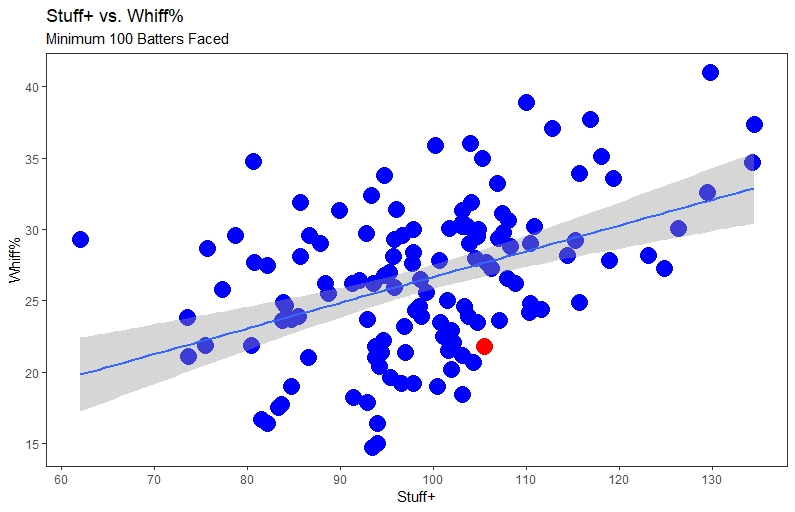
Here we’re looking at all pitchers with a minimum of 100 batters faced. Mize is the point in red, and while it’s not a perfect relationship between Stuff+ and whiff rate, it does look like Mize is a little bit of an outlier here when looking at things in this way. Keep in mind that Mize is a top-35 pitcher (out of 129 qualified pitchers) in terms of Stuff+ at 106, but there is only one other pitcher in the top-50 with as low of a whiff rate as Mize (ironically, it’s another Tiger in Spencer Turnbull). The average whiff rate of pitchers in the top-50 of Stuff+ is 30%, so it certainly seems like something is up with Mize here. This would suggest to me that Mize may be executing his pitches a little inefficiently in terms of both location and his pitch mix. Let’s see if there’s something to this and if some changes here can help Mize get some more whiffs and strikeouts.
Location
Let’s start first with how Mize is executing his pitches, essentially just by looking at pitch command and location. Fastball command and location are arguably most important, so let’s start with Mize’s four-seamer here, as it’s also his most-thrown pitch.
Mize is a “four-seamers up” type of pitcher, which is not unlike many other pitchers these days. That seems like an even better idea for Mize this year, considering the extra tick of velocity as well as the extra rise the pitch is getting due to the changes in release point as discussed earlier. The heatmaps of his four-seamer show that Mize is generally working more up in the zone with the pitch this year:
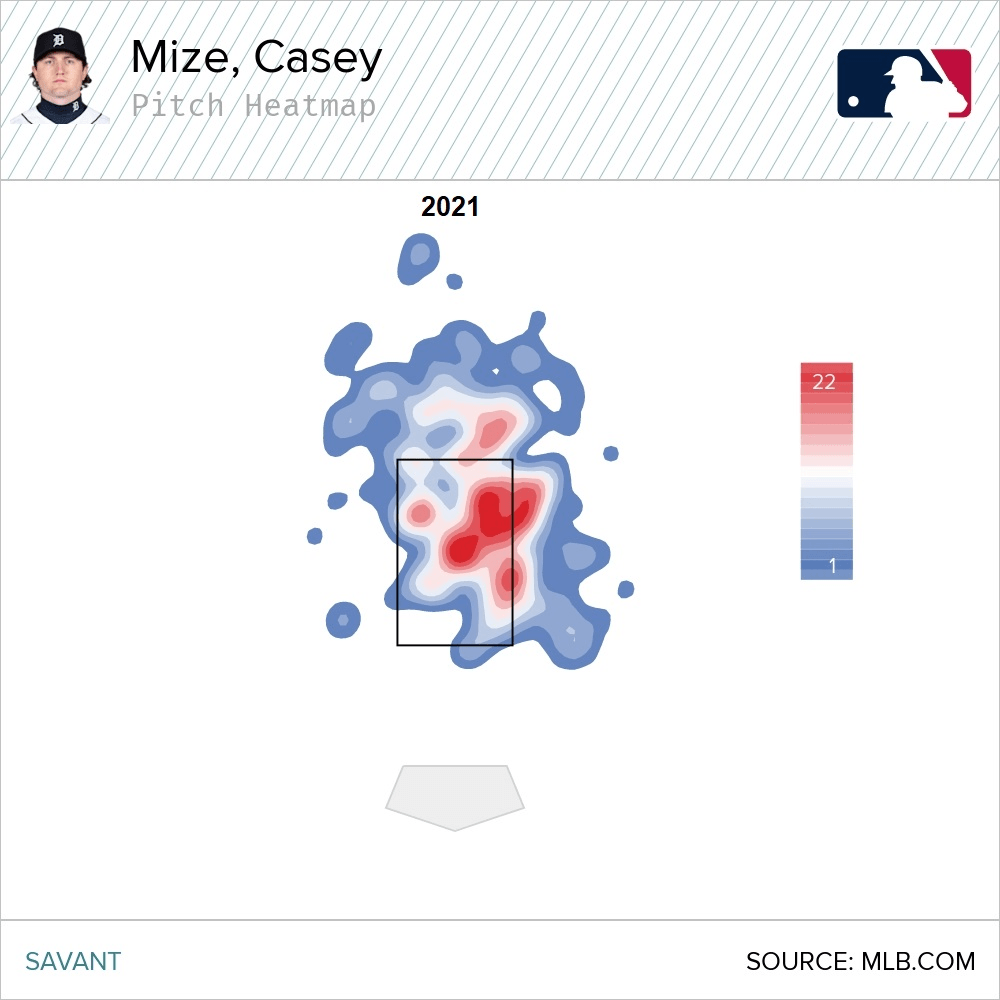
And when looking at whiffs on the pitch, it’s good to see that most of the whiffs have come on pitches up in the zone, which corresponds with the increased rate of pitches up:
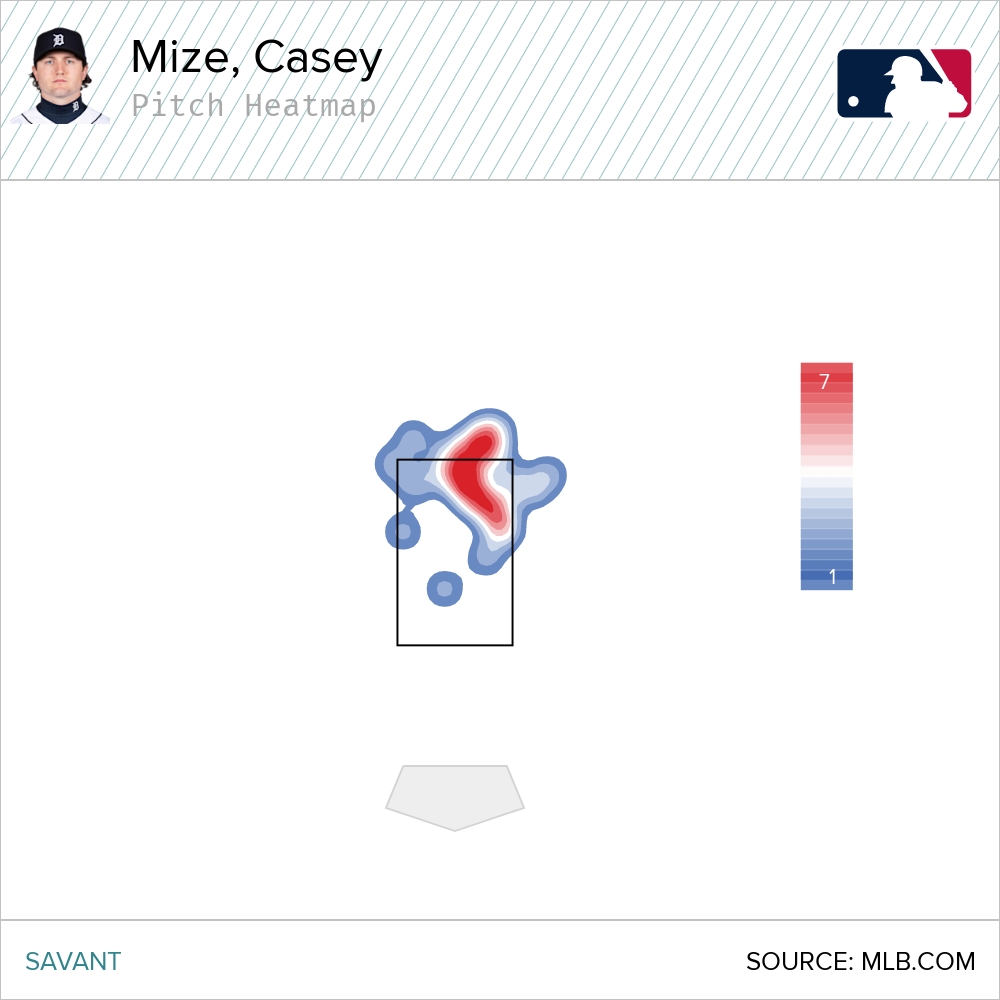
That is good to see, but going back to the pitch’s heatmap this season, it still doesn’t look like Mize is getting up there quite enough, and when he’s missing, he’s missing in the heart of the zone—literally, the dead-center middle of the zone, which hitters are making him pay for. Here’s a look at where the hits have come off of Mize’s fastball this season:
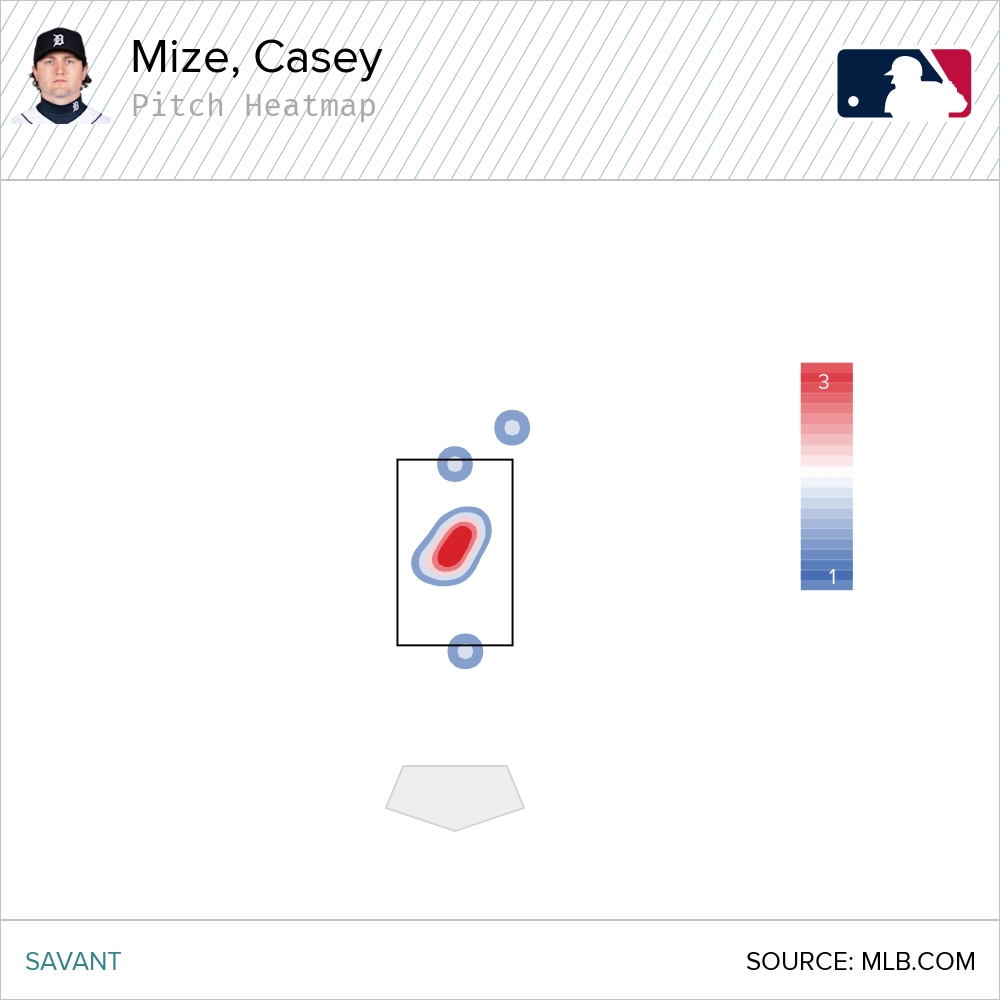
We see that hitters are getting hits when the four-seamer is left in the heart of the plate, which is part of the reason why Mize’s four-seamer has been one of the hardest-hit among starting pitchers so far this season:
So, while Mize’s four-seamer is getting whiffs where it’s supposed to, the location of the pitch has been inconsistent this year, and when he’s missing with location, hitters aren’t, and they’re doing quite a good amount of damage. This has been most notable when looking at Mize’s home runs allowed. Mize has had something of a home run issue since making his Major League debut, but this year, the majority of his home runs allowed came off of his four-seamer:
A lot of the home run issues come back again to pitch location, as not surprisingly, the four-seamers that have left yard this season have been mostly in the middle-middle part of the plate as hitters appeared to have cashed in on his mistakes:
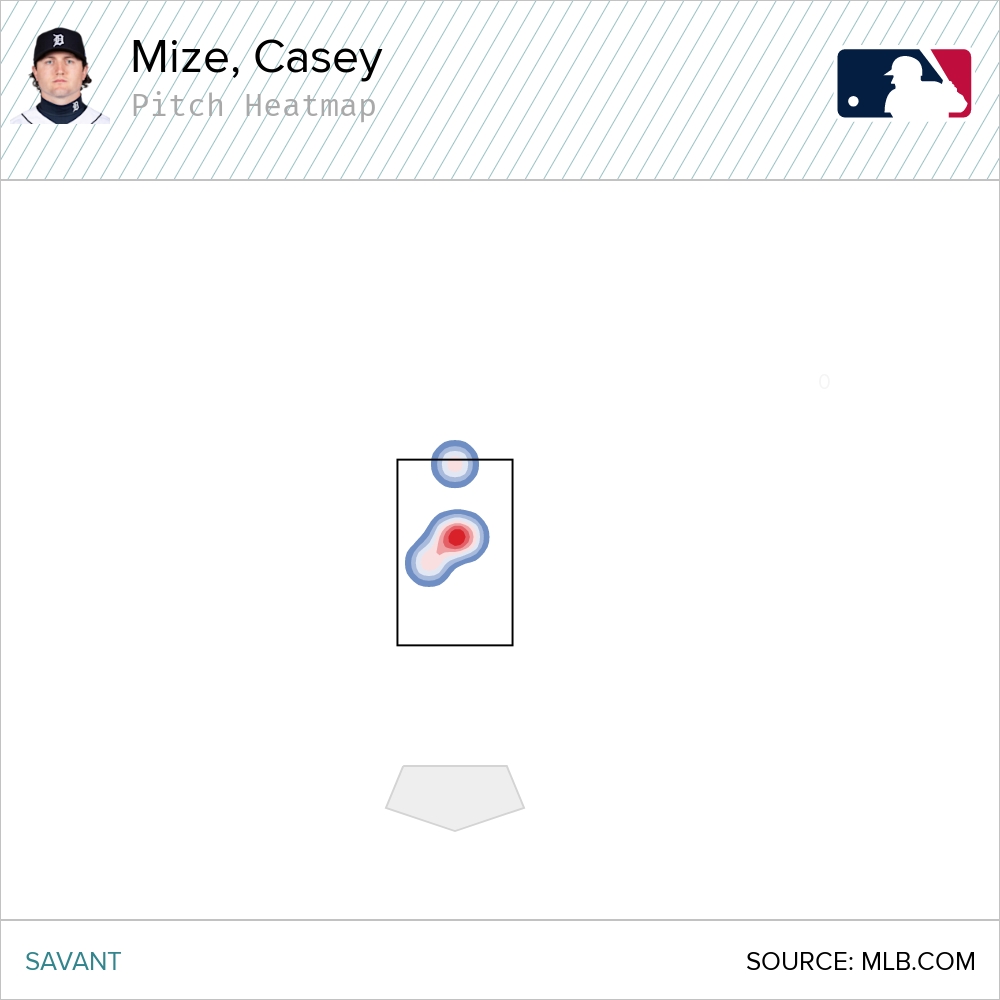
So, it seems clear that if Mize wants to work his four-seamers up in the zone, he’ll have to do a good job of commanding it or else face the risk of more home runs. On a positive note, though, it should be noted that Mize may be coming along in this department. After giving up five total home runs in two straight starts against the Athletics and Royals, Mize didn’t give up a home run in his next three starts, with the fastball getting hit a lot less hard. That’s a good sign, and hopefully, he can keep that going in the future because it’s hard to be a successful pitcher without a quality fastball.
Mize also appears to have a similar location issue with two other pitches: the splitter and sinker. When it comes to the splitter, things are a little bit weird. For whatever reason, the pitch just isn’t moving as much this season as it did last season. The splitter was supposed to be the focal point of his repertoire and his biggest out pitch, but right now, it doesn’t quite look as strong when looking at the amount of drop:
The splitter is a pitch that needs to live down in order to be successful, so less drop on a splitter could spell bad news for a pitcher. That lower drop shows up when looking at the pitch locations—take a look at how many more pitches are up in the zone this year as opposed to last year:
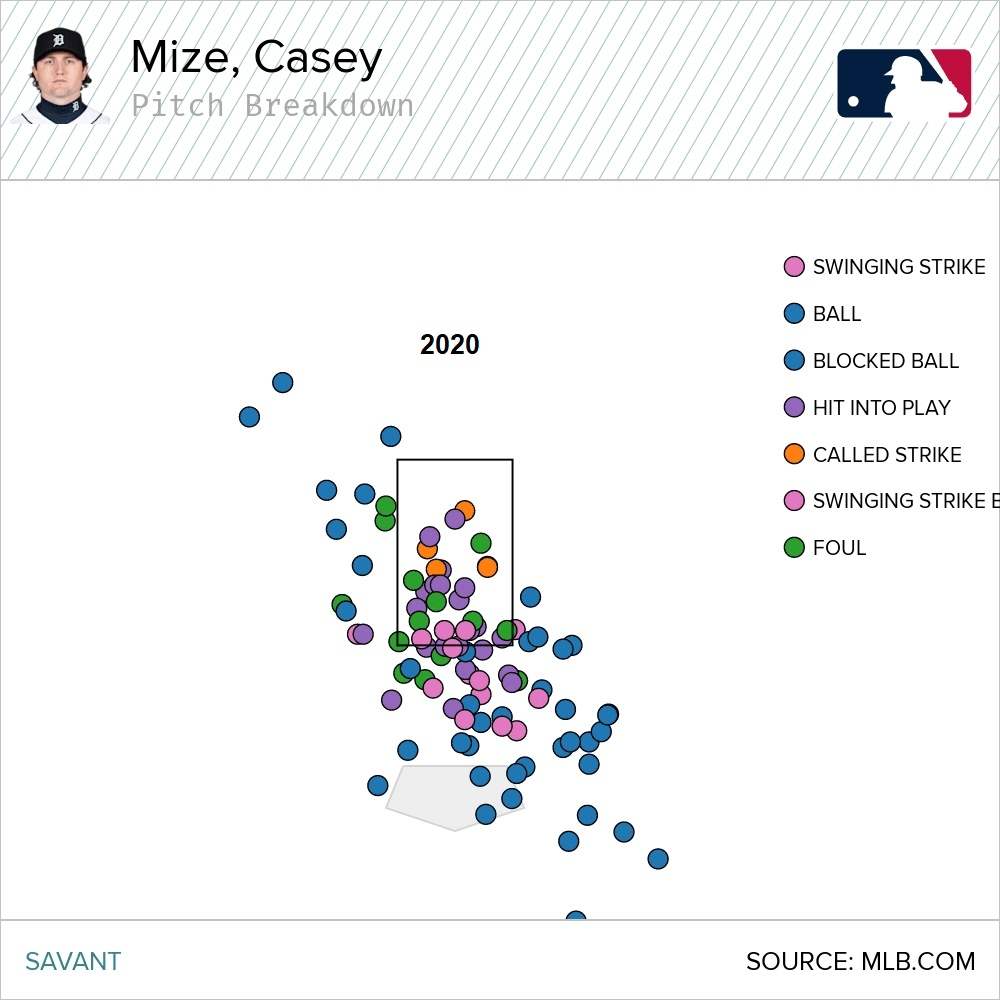
While last season the argument could have been made that Mize was locating too many of those splitters in the dirt or bouncing them before the plate, the overall trend is that most of these pitches are down—and look at where he got swinging strikes—exactly where they should be for a splitter. In 2021 however, Mize is still getting whiffs at the bottom of the zone, but he’s leaving a lot more pitches up in the middle of the zone. It’s not surprising then that the pitch’s whiff rate has been halved this season, down to just 13.8%. When Mize is able to locate it down, it’s getting whiffs for the most part, but similar to four-seamer, he’s just not getting it there consistently enough. The pitch is also getting hit pretty hard by the expected stats (.626 xSLG, .415 xwOBA). Something is just not right with the pitch right now, and it has become less of a focal point in his repertoire at just 17% usage–only more than his curveball. The pitch’s usage has been trending down, too, as the starts have gone on. Most notably, on May 12th against the Royals, he threw just six of them:
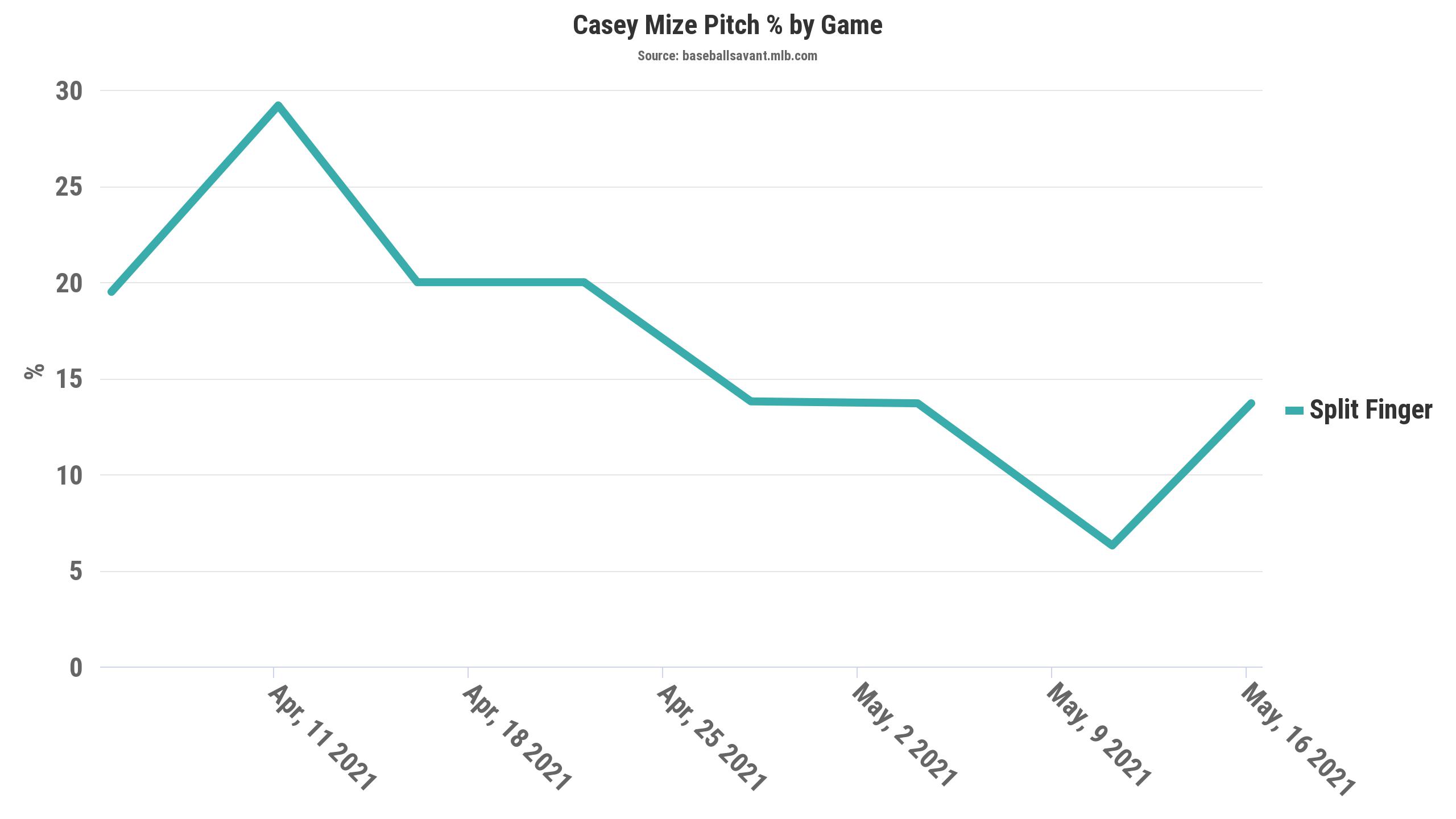
While there’s probably something more complicated going on with the splitter that’s causing Mize issues, I think things are less so when it comes to the sinker; I’m just not quite sure it’s a good pitch. When looking at the sinker’s heatmap, it looks like Mize is doing a good job of working the edge of the zone and keeping it out of the heart of the plate, but it’s still not down towards the bottom of the zone where a sinker would be expected to be:
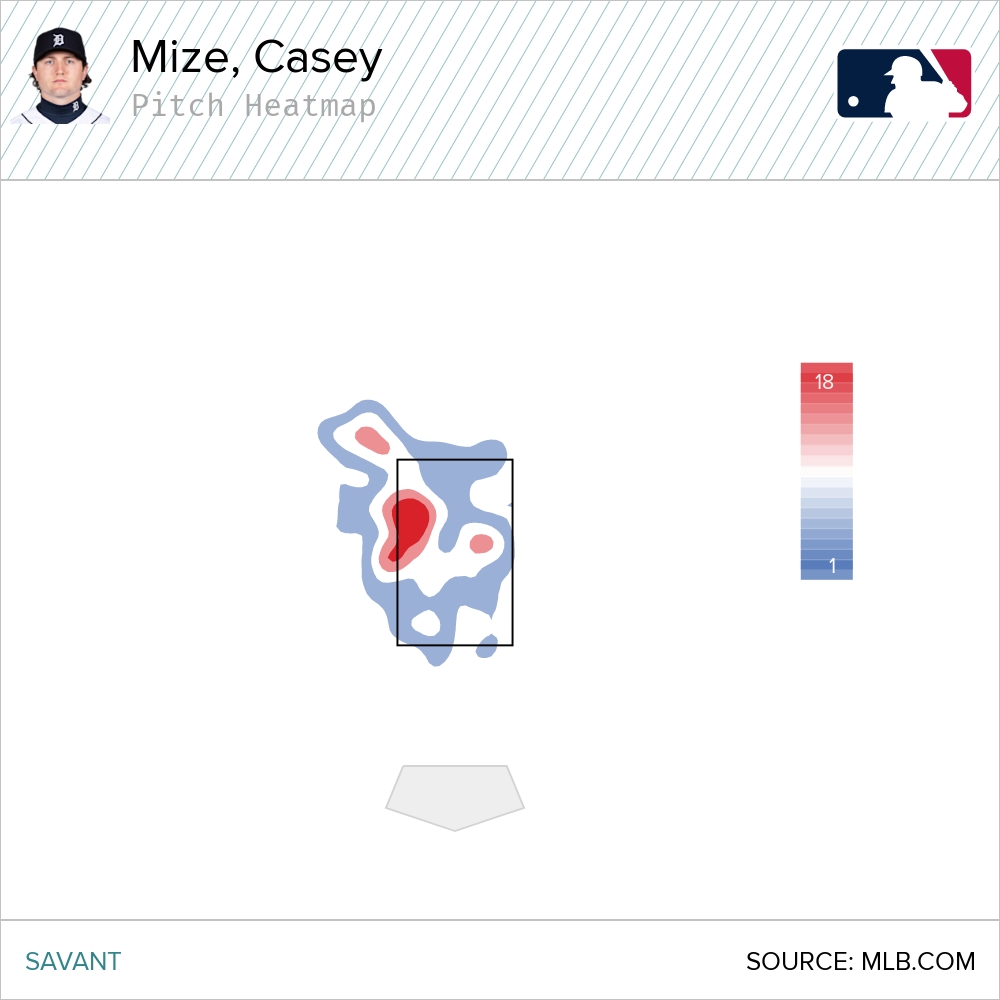
Notably, the pitch does do its job in getting weak contact and groundballs, for what it’s worth, but even with those two things, the pitch still has a .390 wOBA against. He doesn’t have to scrap the pitch completely, it can still be useful, but it seems like he’s walking on thin ice with how he’s locating it.
Pitch Mix
That being said, I think to get more whiffs and ultimately more strikeouts from Mize in the future, he could change his pitch mix a bit. Throwing more of the whiff-ier pitches such as the slider and curveball and less of the sinker would maybe accomplish this. His slider should probably be used more in general, and he’s actually using his curveball less this year than last year. However, I think we can still drill down more specifically on his pitch mix. Changing his pitch mix generally would maybe be a good thing, but I think his pitch mix, let’s say, issues are more magnified when looking at things broken down in two-strike counts, which is when a pitcher is obviously in a prime position for strikeouts. Let’s see this season’s pitch mix breakdown in each two-strike count:
It appears that Mize is turning to his four-seamer quite at a much higher rate in two-strike counts than his other pitches. It seems odd because the thinking would normally be that a pitcher would turn more to their secondary stuff to try and finish hitters off, but not for Mize. Now, it wouldn’t be an issue if all of those four-seamers were being turned into strikeouts at a high rate, but they aren’t—evidenced by the pitch’s below-average putaway rate of 19.1%. This is also quite different than it was in his limited look last season (for easy comparison’s sake, I labeled the classified cutter from 2020 as a slider:
Last season, Mize used the four-seamer a lot less in two-strike counts, and overall, the pitch mix in two-strike counts was more even. He preferred the splitter a lot more last season in two-strike counts, but we saw that his splitter isn’t quite right this season, so it makes sense to see him favor it less this year and turn to the redeveloped slider. All in all, it does seem strange that Mize has preferred the four-seamer at such a high rate in these situations, considering that the pitch isn’t as strong as his non-fastballs. Now, maybe it’s a confidence thing, and that without his trusty splitter doing what it should be doing, he just doesn’t trust his other pitches enough to turn to them at such a high rate. That’s at least a theory, but still, with such a wide repertoire, he could stand to mix things up a bit more. I’m curious to see what Mize would look like in these counts with some changes to his pitch mix–favoring the slider even more and perhaps even the curveball too, and ditto to the splitter if that comes back around.
Although it’s probably not that simple. Mize could be better off changing his pitch mix in two-strike counts, but it also looks to comes back to location again. It’s one thing for a pitcher to throw their better pitches more, but it’s also about putting them in a position for hitters to either swing or have them get called for strike three, and it doesn’t seem like Mize is putting those pitches in those positions enough right now. Take, for instance, the pitch charts of his three primary pitches in two-strike counts (the four-seamer, the slider, and the splitter):
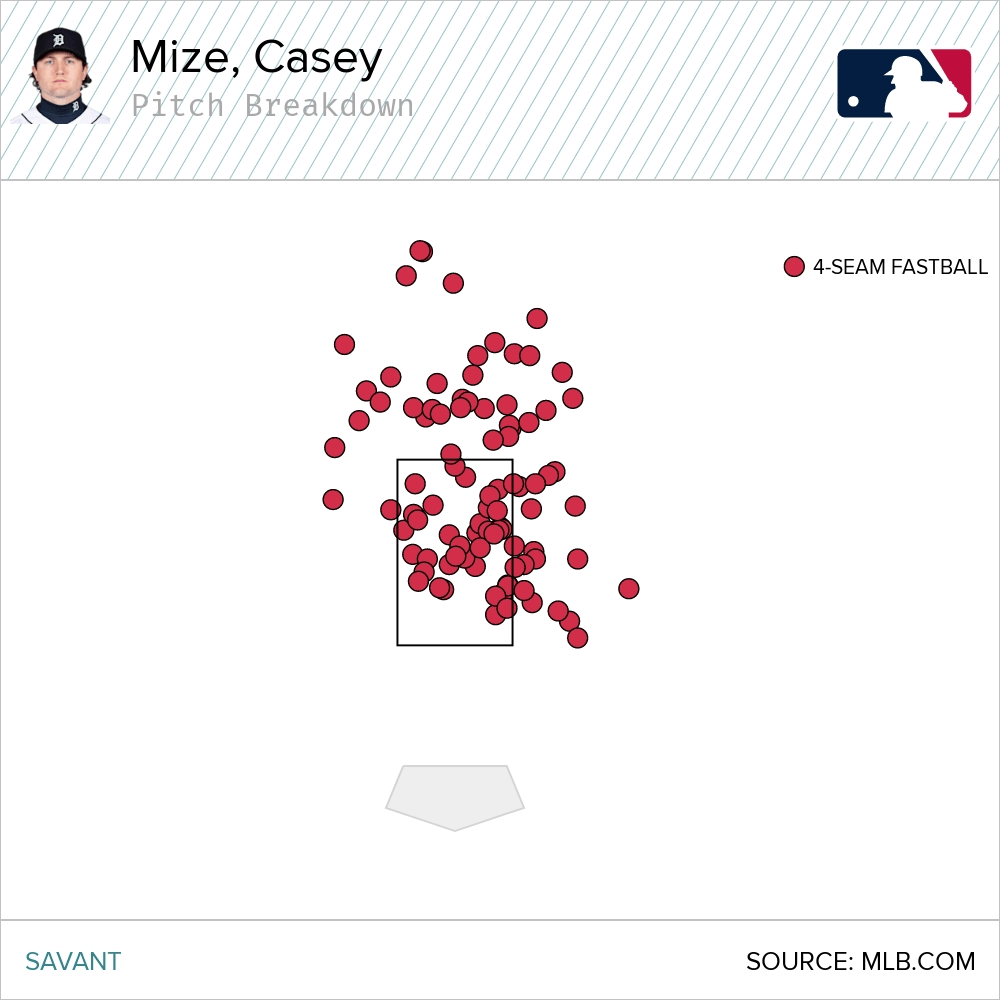
Looking at these pitch locations, it seems like it’s a microcosm of his general location issues. For the four-seamer, he’s trying to locate them up in the zone, but a lot of them have ended up way up out of the zone and generally easy takes for hitters, or they’re missing low in the center of the zone, which should be less difficult for hitters to put in play. While there have been fewer misses up in the zone with the splitter with two strikes as compared to all of his splitters, there are still a lot of pitches ending up in the dirt and look to easier takes for hitters, and just not getting it where it should be on a consistent enough basis. Mize’s slider location has been better overall than his other pitches. Still, on two strikes, it again looks like there aren’t as many pitches that would tempt hitters, with what again looks like some easy takes that run in on left-handed hitters or into other batter’s box for righties. A different pitch mix may help Mize get more whiffs and strikeouts, but that probably isn’t enough on its own. Improving his location should also be a big help in this department.
Conclusion
All in all, Mize already does a lot of things well as a pitcher. He has a vast repertoire of pitches, and due to some release point-related adjustments as well as just having more time to get comfortable in the Majors, they seem to look much better this year. It’s good to see him already making adjustments in the early part of his career as he starts to gain more experience, and he has ultimately made some important steps forward this year. Mize possesses the skills necessary to be a successful pitcher in this era of pitching, but the tinkering and improvements should not be done just yet. He has better stuff, but the command has yet to fully come around, and due to some issues with location along with his current pitch mix, Mize maybe isn’t getting as many whiffs or strikeouts as we would expect from a pitcher with his stuff. Mize is on the right track, and some further improvements in these areas could help him get to that next level and ultimately reach his potential as a former first overall pick.
Photo by Photo by Cliff Welch/Icon Sportswire | Adapted by Jacob Roy (@jmrgraphics3 on IG)

